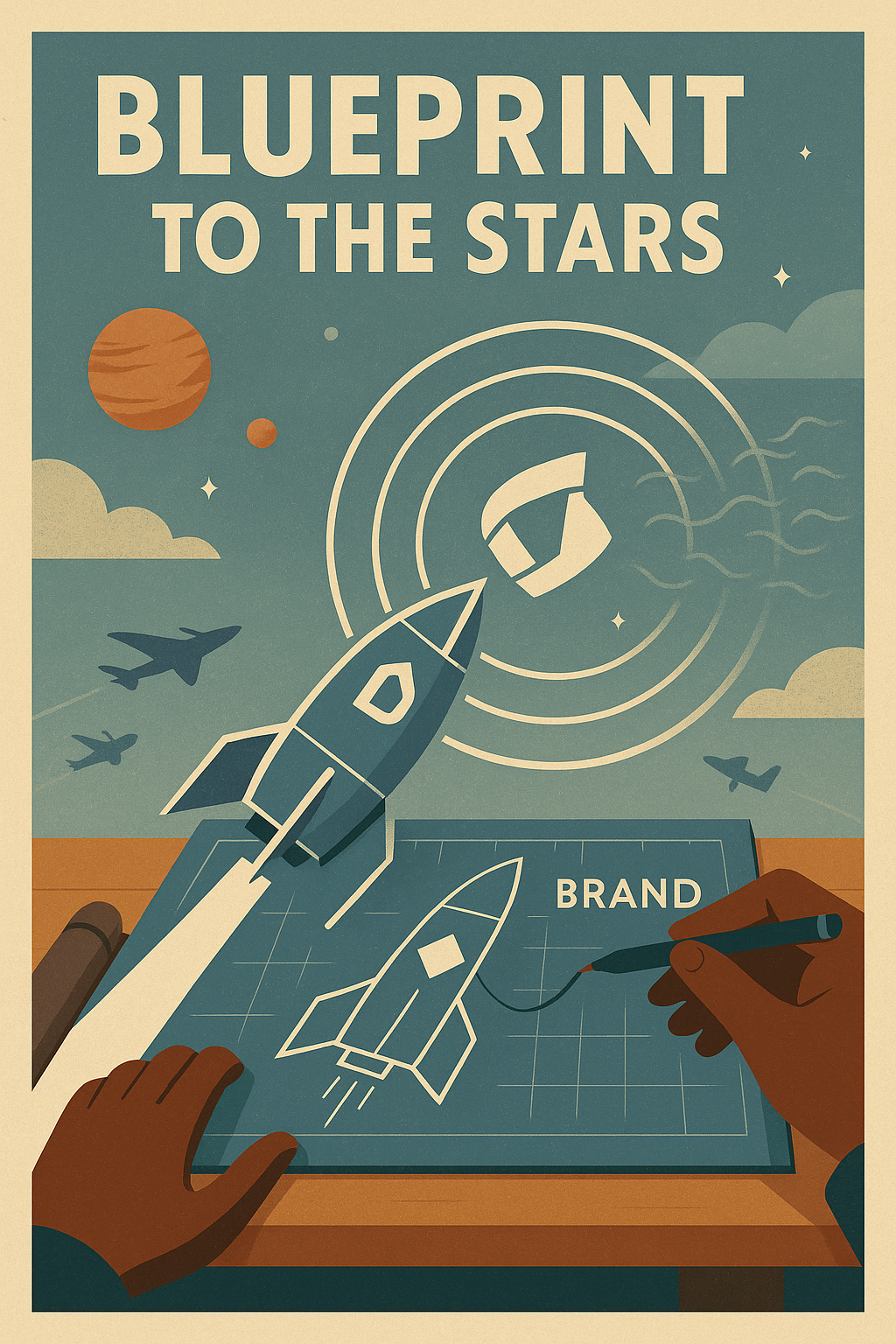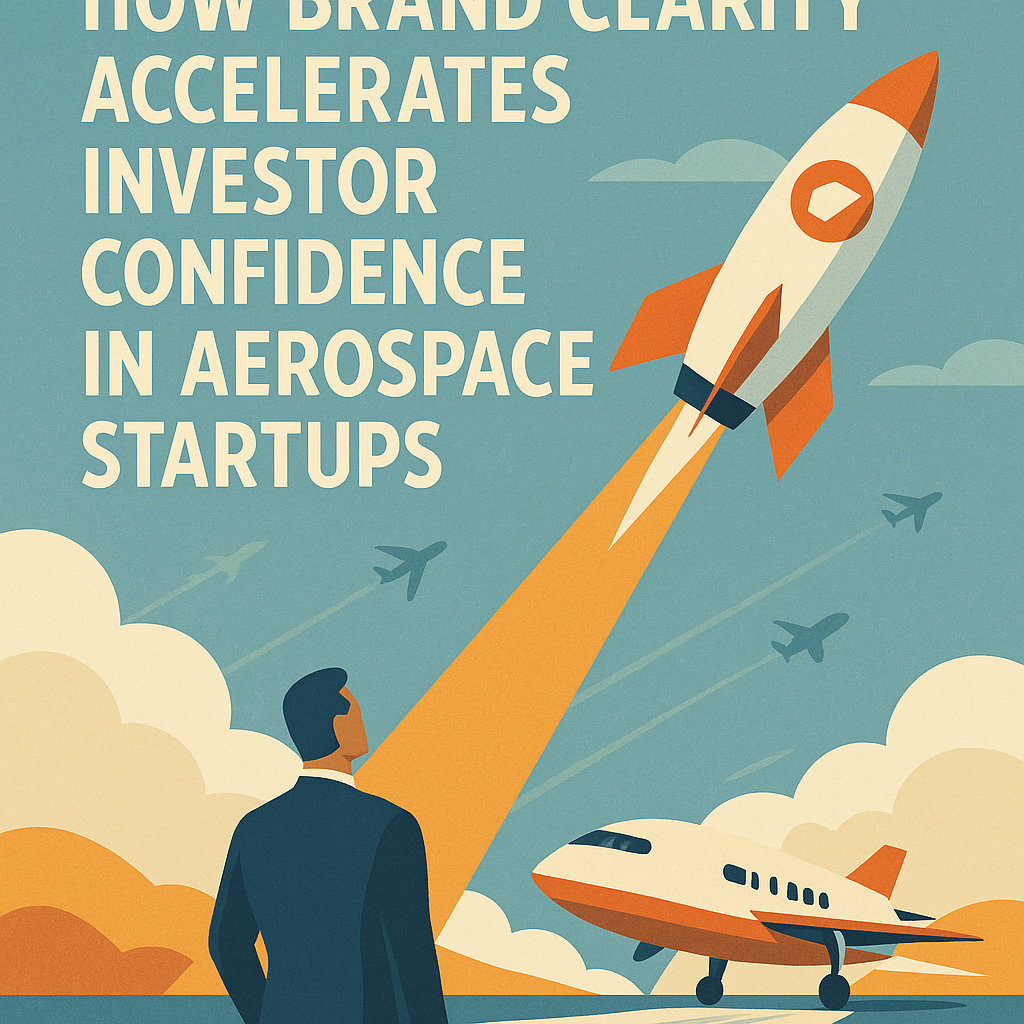You’ve got a groundbreaking aerospace startup idea—maybe it’s a next-gen propulsion system, a cutting-edge avionics platform, or a satellite tech innovation that could change the game.
But here’s the hard truth: investors aren’t lining up yet, and it’s not because your technology isn’t revolutionary—it’s because your brand isn’t telling the right story.
In aerospace, perception equals credibility, and credibility accelerates funding.
Even the most brilliant engineering can get lost in the noise if your brand positioning feels scattered or generic.
The startups that win investor confidence aren’t just engineering marvels—they’re brands that radiate clarity, authority, and a compelling vision of the future.
I’m Viktor, a strategist obsessed with how powerful brand narratives move markets. Over the past 13 years, I’ve helped companies secure millions in funding by shaping stories investors can’t ignore. This guide will show you exactly how to craft brand clarity that cuts through technical jargon, resonates with high-stakes aerospace investors, and fast-tracks the confidence you need to raise serious capital.
Let’s dive in.
Why Brand Clarity Matters in High-Stakes Aerospace Ventures
Investors in aerospace startups don’t just evaluate technology; they assess risk perception.
In a high-stakes aviation industry where timelines stretch for years and millions are tied up in R&D, credibility often outweighs raw innovation.
A well-defined brand strategy acts as a psychological anchor—it signals that your aerospace company is not just a lab experiment but a business ready to execute, scale, and deliver.
Behavioral economics tells us that investors make decisions based on signal vs. noise.
A clear brand is a strong signal: it communicates focus, professionalism, and market readiness, while a poorly articulated brand creates noise, raising doubts about your ability to navigate complex aerospace and defense contracts or acquisition deals.
Mental models like “circle of competence” (Shane Parrish) remind us that investors want to back teams that know exactly where they excel. A refined go-to-market narrative, reinforced through sharp design and logo consistency, helps position your aerospace startup as a specialized partner rather than a speculative bet. In other words, brand clarity reduces investor anxiety, making funding decisions feel safer even in cosmic-scale exploration ventures.
Trust, Transparency, and the High-Stakes Aerospace Industry
In the aerospace and defense sector, trust isn’t just nice to have—it’s mission-critical. Stakeholders from government agencies to aviation companies want partners who can navigate regulatory complexity, protect national security, and deliver on time. A strong brand identity reinforces this trust by showcasing a consistent narrative across all client touchpoints—pitch decks, interactive marketing services, and even trade show booths.
Consider SpaceX and Rocket Lab. Both won early government contracts not just because of engineering prowess, but because their brand storytelling instilled confidence. SpaceX’s sleek logo design, public test transparency, and Elon Musk’s relentless messaging about “shaping the future” turned a risky aerospace bet into a compelling narrative investors wanted to be part of.
A refined brand doesn’t just boost visibility; it fosters confidence that you can deploy technology at scale, meet startup needs, and become a long-term partner in an industry where mistakes cost billions and lives.
Core Components of Brand Clarity in Aerospace Startups
Defining a Singular Value Proposition in a Competitive Aerospace Sector
In a market where aerospace startups compete for attention alongside established aerospace and defense giants, carving out a clear niche is essential.
A singular value proposition (SVP) should answer two questions: Why does this technology matter now? and Why are you the only team that can deliver it?
Applying Blue Ocean Strategy means stepping away from crowded, price-driven markets and creating an uncontested space.
For example, instead of competing with dozens of drone manufacturers, a startup might specialize in high-stakes passenger aircraft navigation systems or cosmic exploration avionics—areas where differentiation, not cost-cutting, wins contracts.
Your SVP should integrate engineering excellence with clear commercial outcomes: Will it boost national security, cut aircraft maintenance costs, or solve complex prototype testing bottlenecks? Investors back brands that refine technology into tangible benefits for target customers, not just those who showcase innovation for its own sake.
Aligning Brand Narrative with Engineering & Technological Innovation
The aerospace industry thrives on technical breakthroughs, but investors are often non-technical decision-makers.
Translating complex engineering concepts—like avionics algorithms or propulsion system prototypes—into compelling stories is key to building trust.
Your brand narrative should focus on outcomes, not technical jargon. For instance:
Instead of “Our AI-driven avionics system uses neural networks to optimize flight paths,” say,
“Our technology reduces fuel consumption by 18% per flight, saving carriers millions annually and improving passenger safety.”
This shift from technical specifications to real-world impact resonates with stakeholders, from venture capitalists to aviation companies exploring strategic acquisitions. Position your startup as a partner that understands both engineering precision and the broader market’s startup needs.
Logo Design & Visual Identity for Aerospace Startups
In a sector where trust and reliability are non-negotiable, design consistency signals professionalism.
A sleek, modern logo and unified visual identity communicate that your aerospace startup takes its brand as seriously as its technology.
Investors subconsciously associate polished design with operational excellence. Consider how SpaceX’s minimalist logo evokes cutting-edge tech and cosmic exploration, while Boeing’s design language reflects a century-long track record in aviation and space company leadership.
Key best practices:
Simplicity with purpose – Avoid overly complex logos; clarity fosters trust.
Industry alignment – Use color psychology (e.g., blue for reliability, metallics for advanced technology).
Consistency across touchpoints – From pitch decks to conference booths, every client interaction should reinforce your brand’s reliability.
A refined visual identity doesn’t just impress; it fosters investor confidence, boosts acquisition potential, and signals you’re ready to bring your product to market on a global scale.

How Brand Clarity Shapes Investment Decisions
For investors evaluating an aerospace startup, clarity equals confidence.
Venture capitalists (VCs) look for brands that signal expertise, operational discipline, and a clear path to product-to-market execution. As Peter Thiel outlines in Zero to One, the most compelling startups don’t just compete in existing markets; they shape the future by creating something truly unique.
In the aerospace and defense sector, this means articulating how your technology—whether it’s a next-gen propulsion system or AI-driven flight automation for aviation companies—can define a new market niche rather than simply iterate on existing solutions. A strong brand strategy demonstrates that you understand your target customers, regulatory hurdles, and the steps to scale, which reassures investors that their capital will be deployed with precision.
Your brand should communicate three critical signals to VCs:
Engineering mastery backed by a specialized team with a proven track record.
Market readiness, including validated demand and clear startup needs alignment.
Visionary insight, positioning your aerospace firm as a future-defining partner rather than a speculative bet.
Reducing Perceived Risk Through Strategic Communication
In high-stakes industries like aerospace and defense, investors fund startups they trust to execute under pressure. Drawing from Peter Drucker’s The Effective Executive, demonstrating operational maturity is key to reducing perceived risk.
A brand that clearly communicates decision-making frameworks, engineering rigor, and a disciplined approach to scaling is far more attractive than one relying solely on technical buzzwords. For example:
A space company that shares transparent testing milestones and refined safety protocols positions itself as a lower-risk investment.
An aerospace startup that publishes clear timelines and engages in proactive stakeholder updates shows it can navigate the complexities of regulatory compliance and manufacturing.
Strategic communication—through investor briefs, interactive marketing materials, and transparent public updates—fosters confidence that your startup isn’t just innovative but operationally sound.
The Role of Public Relations & Thought Leadership in Aerospace Investment
In the aerospace industry, reputation travels fast—and the right narrative can boost investor interest before you even enter a funding round.
Public relations (PR) and thought leadership aren’t just about visibility; they’re about positioning your brand as an authority among key stakeholders.
Industry events and trade shows serve as critical trust-building platforms. Presenting at a major aviation conference or demonstrating at a cosmic exploration summit allows you to showcase prototypes, secure strategic partners, and attract client attention from established aerospace firms.
Strong PR also plays into mergers and acquisitions (M&A) opportunities. Companies in the aerospace sector often scout innovative startups for strategic acquisition, and being consistently visible as a thought leader—through panel discussions, white papers, or expert commentary—can foster investor confidence and attract suitors.
A well-executed thought leadership strategy positions your brand not just as a startup seeking funding but as a future partner shaping the aerospace industry’s next chapter.

Practical Strategies to Build Investor-Ready Brand Clarity
A Five-Step Framework for Aerospace Startups
Winning investor confidence in the aerospace and defense sector isn’t just about having breakthrough technology—it’s about presenting a clear, trustworthy brand narrative that convinces stakeholders you can deliver in a high-stakes environment. Below is a five-step, entity-driven framework tailored for aerospace startups looking to secure serious funding:
1. Define Your Core Narrative (Why → How → What)
Simon Sinek’s Start With Why provides a timeless model for shaping investor perception. Investors fund startups that articulate a purpose beyond profits.
Why: Clarify the mission. For example, “Our space company exists to make cosmic exploration safer and more accessible.”
How: Explain the method. “We’ve developed a proprietary engineering system that cuts aircraft prototype testing time by 40%.”
What: State the product. “A next-gen avionics platform already validated by key aviation partners.”
By structuring your pitch around why your work matters now, you boost investor trust and position yourself as a mission-driven partner, not just another aerospace startup chasing funding.
2. Visual Identity Optimization (Logo, Typography & Color Psychology)
Investors subconsciously associate brand design with operational competence. A refined logo and consistent visual identity can foster credibility as much as a technical breakthrough.
Best practices for aerospace startups:
Logo Design: Keep it simple and scalable. A clean tech-inspired design suggests precision and reliability—think SpaceX or Boeing.
Typography: Use sleek, modern fonts that reflect innovation without sacrificing readability.
Color Psychology: Blue suggests trust and reliability, metallics hint at advanced technology, and bold accents (like red or orange) can evoke energy and entrepreneurial drive.
Every investor-facing document, from pitch decks to aviation conference materials, should maintain consistent design standards to refine brand perception.
3. Investor-Focused Storytelling (Using Contagious’s STEPPS Framework)
Jonah Berger’s Contagious teaches us that ideas spread when they hit emotional and social triggers. For aerospace firms seeking funding, applying the STEPPS framework (Social Currency, Triggers, Emotion, Public, Practical Value, and Stories) can boost investor engagement.
Example:
Social Currency: Share how your tech is being evaluated by a top-tier aviation client or aerospace partner.
Emotion: Highlight the high-stakes impact—“Our drone tech can save lives in disaster response missions.”
Stories: Use real-world narratives about pilots, engineers, or stakeholders benefiting from your innovation.
A compelling story moves your startup from just another tech pitch to a future-shaping investment opportunity.
4. Thought Leadership Positioning (LinkedIn, Forums, Keynotes)
Investors trust brands that are already recognized as industry authorities. Proactive thought leadership can foster trust before a single pitch meeting.
Publish insight-rich articles on aerospace forums and LinkedIn, discussing engineering trends or mergers and acquisitions in the sector.
Participate in aviation industry events and cosmic exploration summits as a panelist or keynote speaker.
Collaborate with tech consult partners to co-author white papers, further cementing your reputation as a credible entrepreneurial leader.
Thought leadership ensures that when investors look for aerospace startups, your brand already feels like a trusted partner.
5. Consistent Communication Across Investor Touchpoints
Consistency is crucial in building investor confidence. Every interaction—pitch decks, trade show booths, email updates, or interactive investor webinars—must align with your core narrative and brand strategy.
Key tips:
Refine messaging regularly to reflect evolving startup needs and market shifts.
Boost transparency with regular investor updates, showing measurable progress on engineering milestones and product-to-market timelines.
Foster relationships post-investment through structured follow-ups, strengthening trust and positioning for future acquisition opportunities.
Case Studies & Lessons from Leading Aerospace Startups
SpaceX, Rocket Lab, and Emerging Players
When it comes to aerospace startups, few names illustrate the power of brand clarity better than SpaceX and Rocket Lab. Both companies transformed from high-risk space companies into investor magnets by presenting a clear, future-driven narrative.
SpaceX: Beyond revolutionary engineering, SpaceX’s brand strategy positioned it as a mission-driven company determined to make humanity a multiplanetary species. The minimalist logo design, bold public test demonstrations, and Elon Musk’s consistent messaging created an irresistible narrative for investors and government clients. Despite multiple launch failures early on, its strong brand clarity—rooted in purpose, transparency, and technology credibility—helped it secure NASA contracts and billions in funding.
Rocket Lab: Unlike SpaceX’s grand-scale colonization narrative, Rocket Lab carved a niche in high-frequency satellite launches, positioning itself as the “FedEx of space.” Its marketing strategy focused on practical value, reassuring investors that it could meet commercial startup needs for rapid, affordable satellite deployment. This clarity helped Rocket Lab attract venture capital and successfully list on NASDAQ, signaling market readiness to a broader investor base.
Emerging players, such as Relativity Space and Astra, are following similar patterns—focusing on tech innovation (3D-printed rockets, rapid assembly) while building a brand narrative that resonates with investors who want to foster high-stakes innovation but demand a clear path to market.
Lessons from Aerospace & Defense Companies Entering New Markets
Established aerospace and defense firms also demonstrate how brand clarity accelerates growth when entering new markets.
Boeing’s Venture into Space Tourism: Boeing leveraged its century-long track record in aviation and aerospace engineering to gain investor and regulatory confidence for its Starliner space capsule. By aligning its brand with reliability and safety, it positioned itself as a trusted partner for NASA and commercial clients in a cosmic exploration market where trust is paramount.
Lockheed Martin & Emerging Tech Acquisition: Lockheed Martin has strategically acquired smaller tech startups specializing in AI-driven aviation systems and hypersonic technologies. Its brand—long associated with precision and national security—reassures stakeholders that these innovations are vetted and market-ready, minimizing perceived investment risk.
Airbus & Urban Air Mobility: Airbus applied entrepreneurial marketing when entering the high-stakes urban air mobility sector with its CityAirbus prototype. By showcasing interactive design models at aviation conferences and emphasizing its global supply chain reliability, Airbus convinced investors and city governments to fund pilot programs, despite this being a completely new startup-like venture for the aerospace giant.

Key Takeaways & Action Plan for Aerospace Entrepreneurs
Securing funding in the aerospace and defense sector isn’t just about cutting-edge technology—it’s about communicating your value in a way that builds trust with investors. Below is a quick action plan and a table summarizing how brand clarity directly impacts investor confidence.
Investor-Focused Brand Clarity Steps
Define Your Core Narrative (Why → How → What): Clearly state why your aerospace startup exists, how your engineering innovation solves urgent startup needs, and what tangible outcomes investors can expect.
Refine Your Visual Identity: A professional logo, consistent design, and clean marketing materials signal operational maturity to high-stakes investors.
Tell Investor-Ready Stories: Use emotionally compelling narratives, like how your tech innovation improves aviation safety or enables cosmic exploration, to foster trust.
Position as a Thought Leader: Publish insights, speak at aviation conferences, and form strategic partnerships to build credibility as a trusted partner.
Maintain Consistency Across Touchpoints: Every client and investor interaction—from pitch decks to trade shows—should reinforce the same message of reliability, precision, and readiness for acquisition or scale.
Foster Transparency: Share measurable milestones and demonstrate disciplined project management to reduce perceived investor risk in this high-stakes industry.
Brand Clarity Elements vs. Investor Confidence Impact
| Brand Clarity Element | What It Signals to Investors | Impact on Investor Confidence |
|---|---|---|
| Core Narrative (Why → How → What) | Strategic focus & future-shaping mission | Boosts trust in long-term vision |
| Visual Identity (Logo, Design, Colors) | Professionalism & operational readiness | Fosters credibility & lowers risk perception |
| Investor-Focused Storytelling | Real-world relevance & emotional connection | Refines investor interest & drives engagement |
| Thought Leadership & PR | Industry expertise & market authority | Positions startup as a trusted partner |
| Consistent Communication | Reliability & transparency in execution | Boosts investor willingness to fund high-stakes projects |
| Transparency & Milestone Reporting | Discipline & risk management | Fosters long-term investor relationships & acquisition potential |
A clear, consistent brand doesn’t just boost funding rounds—it positions your aerospace startup as the obvious choice for investors, strategic partners, and future acquisitions. In a market where technology and engineering breakthroughs are expected, brand clarity is what sets you apart.

Conclusion: Brand Clarity as a Catalyst for Investment
In the high-stakes aerospace and defense industry, brand clarity is more than just smart marketing—it’s a funding accelerator. Investors don’t just bet on technology; they invest in brands they trust to execute complex engineering projects, navigate regulatory challenges, and deliver measurable outcomes.
For any aerospace startup, clarity equals credibility. A strong brand narrative, refined visual design, and consistent messaging across investor touchpoints reassure stakeholders that you are not just an innovative space company but a reliable partner ready to meet critical startup needs.
When executed well, brand clarity boosts investor confidence, fosters strategic partnerships, and even positions your company for future acquisition opportunities. Whether you’re pitching to venture capitalists, showcasing at aviation conferences, or consulting with potential clients, your brand should consistently communicate three things:
Why you matter now (mission-driven purpose).
How your tech innovation solves urgent problems (market readiness).
What makes you the right team to deliver (trust through transparency).
In an industry where every decision carries high-stakes consequences, brand clarity is the difference between being overlooked and being funded. If you want your aerospace startup to shape the future, start by shaping the story investors will believe in.









